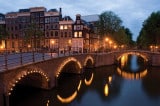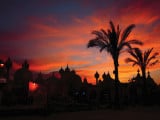Despite the recession, generations of Irish are still beating a path to the Canaries, in the virtual certainty of year-round sun. By Yvonne Moran.
The Berbers settled on the islands before Christianity, the Spanish arrived in the 15th century and the first charter flight in the 1960s was Scandinavian.
Fast forward to the 21st century and almost four million tourists visit Gran Canaria every year. And 80,000 of them are Irish.
The Canary Islands is the winter destination beloved by 300,000 Irish sun worshippers. Despite the recession, generations of Irish continue to visit; many are repeat tourists, hoping to find almost guaranteed sun on islands lying just off the West African coast.
Gran Canaria, which lies 210km from that coast, and 1,250km from Cadiz, the nearest point on the European mainland, is one of the most popular of the seven islands.
Maria and Michael Reilly, who live in Dublin 8, have been to Gran Canaria about 20 times. “We first visited 10 years ago for my 40th birthday,” said Michael, who’s a barman. “There’s guaranteed sunshine there in winter, and we usually go for one week and stay in an apartment in Puerto Rico,” their favourite spot. Prices are very reasonable, he said, and the couple spend their time “relaxing, sitting by the pool, going for morning walks, eating in local restaurants and enjoying a few drinks. I hope eventually to go for one month,” he said.
“We brought the kids year after year – there’s loads for kids to do, like the water park in Maspalomas, boat tours, excursions to see dolphins” and water sports, said Maria. “Erica, my daughter, met her husband Karl in Gran Canaria when she was 18, and they got married there in June 2010. The wedding reception in Gloria Palace Hotel was fantastic – out of this world,” the 49-year-old said. “We arranged a surprise barbecue in Marina Suites next day with a singer from the Drifters and that was also fabulous,” said Maria, of the Puerto Rico apartment hotel which is situated beside a very picturesque marina.
Besides the southern coast’s sun, sea and sand, Gran Canaria boasts several ‘should see’ cultural sights, spectacular landscapes and some lovely inland towns and hamlets. The countryside is also a great place for rural tourism.
Spend a day also exploring Las Palmas, the island’s north-eastern capital. It’s an easy bus ride on the GC 1 auto route from any of the southern resorts.
Before 1492, the island people had contacts with West Africa and Europe. After Christopher Columbus ‘discovered’ America, the Canaries became ‘the roadway and port to the New World’, according to information gleaned in Columbus House museum, in Vegueta. It’s one of Las Palmas’s oldest areas. The great explorer stayed in the then governor’s abode three times on his way to the New World.
A large and lovely model of a 17th-18th century galleon, nautical instruments, small wooden models of the Nina, Santa Maria and Pinta, Columbus’s first transatlantic vessels, and maps detailing his four major voyages are displayed in the beautiful old house designed around an interior plant and flower-filled courtyard. The Canaries became the crossroads between three continents – a market for all manner of food and drink – sheep, goats, pigs, cheese, sugar cane, bananas, wine and spirits. Its inhabitants also emigrated to the New World.
Calle Dr Chil, nearby, is one of Vegueta’s most attractive streets. San Agustin Church, at one end, is the oldest church in Gran Canaria; it was crowded midweek because of a devotion to Santa Rita.
Check out the rainbow-coloured tropical fruit and vegetables in Vegueta Market before heading north to nearby Mayor de Triana. The principal pedestrian shopping street in southern Las Palmas is a great place to imbibe a Tropical, the local beer, and watch the world pass by.
At times called the ‘miniature continent’, you can see palm and pine trees, volcanic craters, cave houses, (some still inhabited), traditional villages and the 2,000-metre Pico de las Nieves, the island’s highest point, on an excursion into the island’s interior. You will also see some of the Canary islands’ 500-plus indigenous plants en route.
Enjoy a traditional Sunday lunch in Tagoror cave restaurant, at Guayadeque Ravine. Try ‘ropa vieja’ – the Spanish for ‘old clothes’ – a chickpea stew. Fried black pudding, young goat meatballs and sancocho, a Canarian fish speciality, are also on the menu.
A visit to the beautiful village of Aguimes, one of the eastern region’s most attractive towns, followed. It boasts brightly-coloured houses on small, traffic-free streets. The Neoclassical San Sebastian church is located on the lovely Plaza de la Rosario in the centre.
You can also tread on sand dunes in Maspalomas, a short walk from the lovely Palm Beach hotel on Maspalomas beach, several hours after requiring a sweater for the island’s mountainous interior.
Aside from lolling in a hotel pool or dipping one’s toes into the sea, Gran Canaria boasts lots of water-based activities.
Angel and parrot fish, a conch shell with a resident hermit crab, a well-hidden, poisonous star gazer fish, colourful nudi branchs, and a cute little puffer fish, were spotted during a very cold dive in Arinaga el Cabron. The marine park, which is south of the airport on the east coast, near Arinaga village, is one of the islands’ best dive spots.
If you don’t dive, you can parasail, jet and water-ski, kayak, use pedal boats, windsurf, or try to stay afloat on a banana boat. A fun morning was spent riding jet skis and parasailing off Playa de Mogan; for the group’s landlubbers, a submarine ride provided them with a new water experience, while remaining dry. Mogan Beach is located beside the lovely Puerto de Mogan, on the island’s south-west coast. Sometimes called the “Venice of the Canaries”, the low-rise, white painted bougainvillea-dressed little houses wrapped around a lovely marina dotted with alfresco restaurants is the southern coast’s most attractive resort.
Several days spent in Hotel Rural Las Longueras, a 19th-century farmhouse near Agaete in the north, indicated that there are lots of tourists visiting Gran Canaria to hike and spend time enjoying the peace and quiet that comes from being “far from the madding crowd”.
La Hacienda del Buen Suceso is situated amongst one of the island’s oldest banana plantations. Hotel El Buho Crea, which served delicious food, sits between mountains.
They reflect some of the variety in accommodation available in rural tourism. Tom Jones, Julio Iglesias, King Juan Carlos and Queen Sofia have all signed several of the 6,000 barrels in Arehucas Rum Factory; sugarcane was like ‘white gold’ before it and the growing of bananas moved to the Caribbean after sourcing water became a problem in the Canaries.
Whether it’s the sun, the great outdoors or easy livin’, Gran Canaria continues to draw visitors to its shores.
Information: Getting there and staying there
Aer Lingus flies from Dublin to Gran Canaria three times weekly on Tuesday, Thursday and Saturday.
For more information on schedules and fares, visit www.aerlingus.com
Accommodation
- Palm Beach: Room rates start from: €102 for a twin room with single use; €149 for a double room. Half board and all taxes are included.www.seaside-hotels.com
- Hotel Marina Suites: Room rates start from: €86.00 for a standard room. www.marinasuitesgrancanaria.com
Rural Tourism
- Finca Las Longueras: Room rates start from €60 for a double room, single use. A double room starts from €90. Breakfast and local taxes included. www.laslongueras.com
- For information on hotels in rural areas contact: www.grancanariafincas.com
Recommended official guides
- Tobias Pujol de Riemer: Tobias charges €90 for a full day. (Negotiable.)
- Taurito Water Sports: www.grancanariajetski.com





